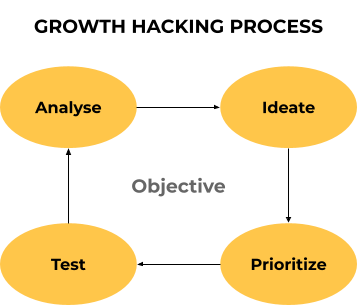In this blog, learn about actionable growth hacking tips, processes, frameworks, tools, techniques, and real-world examples.
Sean Ellis, who coined the term “Growth Hacking” in 2010, says,
“A growth hacker is a person whose true north is growth. Everything they do is scrutinized by its potential impact on scalable growth.”
You must be wondering, “How can I use growth hacking for my business?”
“Is there a growth hacking framework?”, “Can I have some growth hacking tips? Any example growth hacking case?”, “What are some growth hacking tools?”

Today, let’s tackle them all one by one. But, before I move on, let me tell you a short growth story because understanding the growth process is essential.
And once you are good at the process, you can develop your own growth hacks. You won’t need the tips. But if you feel otherwise, please skip to the growth hacking tips and examples.
A Short Growth Story
Imagine you started a running shoe brand. You spent some time researching your competitors and then crafted your product of the best quality.
Whoever needed a shoe and tried your product immediately bought it. Now, it’s just a matter of reaching out to new people. So you started going door to door selling shoes to people.
5 out of 50 people you approached bought your shoes. You spent an entire day selling five pairs. You are not satisfied. That night, you thought this process was too time-consuming and not scalable.
The following day, you bought a phone directory and started calling people in your area and only visited the homes of people who showed some interest.
You made 150 calls. 20 agreed to see the shoes, and 10 out of 20 bought them. You doubled your sales for the day. Good job.
But, after a bit of party, you realized that the current process is not generating enough sales.
Instead of visiting these guys, you thought I should focus on places where I can find these people together in significant numbers.
So you started selling shoes by visiting parks, playgrounds, and other hubs during the day with your car filled up with shoes.
You raised that sales number from 10 to 20 per day. God, you are on fire, but you are still not happy. You opened that phone directory again and started arranging meetings with the shoe distributors of your town.
After 20 meetings, in 5 days, you got orders of 500 pairs of shoes—a jump of 500%. 100 pairs in a day from 20 pairs a day.
You are happy with the results. But you are still not pleased with the process. You don’t think it is scalable.
You want to reach every country distributor, but you are alone. It would take you ages. So you started building an army of consultants and gave them a share in the profits.
You told them what you did to sell those 500 pairs and asked them to repeat that in their locations. That sales number went up from 500 to 5000 pairs a day.
Congratulations, now you are happy, and your business is growing exponentially.

And please don’t blame me if that resembles the growth story of Nike.
I thought I would tell you this story to declutter this “growth hacking” buzzword and point out that there is nothing fancy here.
Let’s understand the takeaways of the story:
- First, make your product (shoe) ready for the market and ready for growth. That’s the first condition for growth hacking.
- Second is the relentless pursuit of chasing that one goal or metric, (For example - Number of purchases per month for Amazon, Number of nights booked for AirBnB ). In growth hacking terms, it is called OMTM or North Star Metric.
- Third, a growth mindset to brainstorm new ideas/experiments/channels to grow the north star metric. That requires creativity and analytical thinking.
- Fourth, executing fast and finding a hack (consultant network in the example) that is scalable and gives exponential growth without burning cash.
The above four points are good enough to understand the growth hacking philosophy. Now let’s move forward.
What is Growth Hacking?
Identifying the quickest, cheapest, and most scalable process to achieve your marketing objective is “Growth Hacking.” The marketing objective could be acquiring, engaging, or retaining customers.
As we have the foundation right, let’s deep dive into the process of Growth Hacking.
Growth Hacking Process
Every growth hacking process starts with a business objective. To identify an objective, you need to identify the customer lifecycle stage to apply growth hacking.
You can visualize the customer lifecycle through a famous funnel known as the pirate funnel or AAARRR (Awareness, Acquisition, Activation, Retention, Revenue, Referral). You can always modify this as per your product or service.
Once you are sure about the objective of your growth hacking efforts, you can easily derive a north-star (or OMTM) metric for focus.
For example, if you want to work on the funnel’s acquisition stage, “Leads” could be your north star metric. You would do growth hacking to improve the number of “Leads.”
Now, here is the simple process of growth hacking.

Analyze
Here your objective is to understand your customers completely and identify potential opportunities. If we focus on “leads,” dig into the old data and find insights that will help you better ideate.
Few of the questions you can answer to improve the “leads” metric:
- Which of your traffic sources is getting you the most leads?
- What are the demographics or behavioral attributes of your best leads?
- Why do they choose your product over others?
- What do they read or watch on the internet?
Get as many insights as possible to ideate the growth experiments better.
Ideate
Once you have enough insights, sit down alone or with your team to brainstorm new experiments.
For example, if a particular channel gives you a good amount of leads, find new ways to double down your leads from that channel.
You should think about different channels you could use and what kind of hacks you can use in those channels.
Here are a few growth hacking ideas:
- Add a hello bar on the top of the site, which doesn’t take away the reader’s attention like a popup yet is accessible.
- Use thank you pages to generate more shares by adding a social share button to all thank you pages.
- Add a long blog opt-in downloadable file to easily download and use for offline purposes.
Prioritize Your Ideas
Once you have finalized your growth hacking ideas, you cannot just start executing them. You need to prioritize and decide which ones you should focus on.
Though many methods prioritize your growth experiments, the most popular framework is ICE (Impact, Confidence, Ease). There are shortcomings to this framework because it relies a lot on the person's experience prioritizing the idea. The more advanced framework is PXL, developed by ConversionXL, which includes data considerations from all sources during research, such as web interactions, usability, customer feedback, etc.
But to ease you into growth marketing, let’s talk about the ICE framework in this blog,
I - Impact (How much the idea contributes towards the goal)
C- Confidence (What is your confidence level on the idea that it will work)
E - Ease (How easy it is to execute the idea)
You will evaluate each idea on the above three parameters and score out of 10. Next, calculate the ICE score.
ICE Score = Impact Score * Confidence Score * Ease Score
You need to prioritize the ones with the highest ICE score.
Test
Coming to the most crucial part, which is testing your idea. The growth team should have laser focus to execute the prioritized ideas in a given timeline (typically 4-5 experiments running for 4-5 weeks)
Once the execution is done and results come out, the analysis phase starts again, followed by ideation and testing. And this loop continues until a successful growth hack is found.
A successful growth hack is typically scalable using technology and automation. Now that you understand the process let’s use some proven growth tips.
10 Growth Hacking Tips
Side products and tools
Everybody likes a free tool to accomplish their small tasks quickly. That’s an excellent opportunity to give them value and introduce yourself. It also helps generate new leads if you make it a gated tool.
For example - You may have seen various free calculators or tools that achieve different things on the internet. Here is an example of a free calculator. A tool could be as simple as a free invoice generator.
Online course as a drip campaign
You send knowledgeable emails for your products and services. Everybody knows that, and everybody is doing that.
Go one step further, disguise your value-packed content around a topic as an email course and send it to the subscribers over a period. People would be more willing to engage throughout your marketing campaign.
For ex - if you are a wholesaler of FMCG products. Then you can create an online course for retailers about “Retailer Masterclass 101 - How to grow a profitable business”.
Within the course content, you can include links to paid resources too. You can use an email marketing automation tool to start making your online email course.
Repurpose your content
Most businesses keep developing new content, which takes away time and energy. A good hack for content creation is to pull a successful piece of content and convert it into a different content types.
You can use your repurposed content or supply it to a potential partner as a freebie in exchange for a backlink to the original content.
For example, summarize a long-form blog into an infographic and share that infographic with other similar blogs on the internet. The infographic is proven to improve the engagement of blogs, so they will happily agree to embed it if your content quality and value are good.
Utilize other people’s value-driven events/webinars
If you are an expert at something and have years of experience, it’s a good idea to leverage events and webinars which could use your expertise.
These event/webinar organizers often lookout out for experts to speak at their events and provide good value to increase and engage their viewers.
It is an excellent platform to generate new leads for your business. Many growth hackers leverage this approach.
Automate email sequence
Nurturing your audience is necessary to avoid losing money on the table. The journey from a cold lead to a warm lead to a hot lead to a customer should be smooth.
Trying to do it manually will consume your time, and the process will be prone to errors. One good idea is to use an email automation tool and create email drip campaigns based on user interest. You can use Deskera CRM to achieve this.
Offer a free version of your tool
Nobody likes to buy stuff without trying, whether in the physical or digital world.
Let a user get the feel of your product. Offer a free version of your product so he can experience it and see the value.
Make sure you have worked out the user experience here to take the user from onboarding to AHA moment during the free trial. Because that will convert him into a customer.
Leverage retargeting
Have you seen those ads when you feel, "How on earth do they know I want this product”?
That is the simple magic of retargeting. Get into the habit of capturing the audience. You can use tracking tools like a Facebook pixel or Google tracking code to do that.
This would help you retarget and follow them across the internet even after they bounce off your website.
Spiralutics says retargeting campaigns give ten times better results than regular marketing campaigns.
Referral campaigns
Every business knows the benefits of referral marketing, but the gold lies in its correct execution.
Identifying who is most likely to refer your product to others could be a good start. Of course, existing customers could be great brand ambassadors, but who else?
Take, for example, community admins of various big FB groups. Many such admins are looking for good income-generating opportunities out of the community.
Partnering with these community admins and paying them a share on each sale is a good motivation.
OPN (Other people’s network)
Your typical customer is not just visiting your website or using your product. They are using a list of other products and services as well. Making yourself visible when using other products and services could be a great hack to be recalled easily.
For example, if you run a bakery, the same person might be interested in various blogs related to lifestyle or food. Tapping into these communities, developing partnerships, and activating yourself could help you go a long way with your growth efforts.
Listing your product on review or listing websites
People seem to take recommendations from others to try something new in the physical world. In the digital world also, they go on various review sites to get the necessary validation.
It’s a good idea to be present on good review websites related to your business niche and get your current users to rate you there. This will not only help you generate new leads who already trust you, but you could use it as social proof in other marketing channels to convince.
Growth Hacking Tools
- Lead Generation: BuiltWith, Hunter, ZoomInfo
- Marketing Automation: Zapier, Pabbly Connect, Deskera CRM, Hubspot
- No Code Landing Page Builder: Unbounce, Webflow, Deskera CRM
- Copywriting: Copy.ai, Peppertype, Hemingway, Grammarly
- Graphic Design: Canva, Figma
- Email Marketing: Mailchimp, Convertkit, Deskera CRM, ActiveCampaign
- SEO Auditing, Tracking & Reporting: SEMRush, Ahref, AccuRanker
- Schedule Demos: Calendly, Zoom, Meet
- Marketing Surveys: Typeform, Google Form
- Social Media Management: Hootsuite, Buffer
- Web Scraping: PhantmBuster, Apify, Instant data scraping tool on chrome
- A/B Testing: Google Optimize, Unbounce, Optimizely
Growth Hacking Examples
Dropbox
Dropbox gamified its onboarding and provided extra storage to each user who completed an onboarding task such as using the media uploads feature, posting on Twitter, etc.
Hotmail
In the initial days of Hotmail, it appended a line to each outgoing email encouraging people to sign up for a new account on Hotmail. So, that became a free inbuilt promotional hack for Hotmail’s growth.
Airbnb
Airbnb developers found a way to let their users post their listings on Craiglist while posting on Airbnb. It gave the Airbnb listing huge exposure and catapulted Airbnb’s initial growth.
Paypal
In just five months, Paypal ran the most successful paid referral campaigns to grow them from 1 million users to 5 million users. They paid a good amount of commission not available with any other referral program. It attracted a lot of users.
Youtube
Youtube became the first platform to let people earn income, resulting in its initial success.
Back in the 2000s, there were few platforms to help you become independent. So people flocked to create content on Youtube. When good content rose, viewership rose. And the rest is history.
Quora
“Ask questions but wait. You need to answer them first.” It was the gamification hack that Quora used initially.
Once the user answers something, they will get credits which will help them ask questions. It was brilliantly designed because users craved the credits.
Initially, when WhatsApp was launched, there was a typical chicken-egg problem. You need your friends on the platform to start using it.
WhatsApp team knew this, and they carefully built a feature to make it damn easy to invite friends to chat.
And since there were not many competitors, it spread like wildfire.
Spotify
Spotify used multiple growth hacks to fuel its growth continuously. They piggybacked on Facebook’s growth by becoming the default music service through a simple integration.
Apart from using a freemium model, they also made sharing songs and playlists incredibly easy for non-users. The FOMO (fear of missing out) principle worked like a charm for them.
Shazam
Some products just have built-in marketing features. They don’t need social media or advertising. That’s what happened with Shazam.
Their product allowed users to hold the phone closer to the music source to identify it. This generates curiosity because the interaction is social. Other people ask, “What are you doing? Built-in word-of-mouth machine.
Uber
Another example of a superb word-of-mouth growth hack is Uber. During its early years, 95% of all riders heard about Uber from someone who has used it. With every seven Uber rides, one new Uber user was generated.
Referrals were a strong growth engine. Each user was assigned a referral code. If a new user signs up with the code, both parties are awarded $10 as the next ride credit.
Deskera
When Deskera launched its one-of-a-kind integrated mobile business app for free in the market, it leveraged the first-mover advantage.
The small and medium businesses were starving for good business apps that could help them run their whole business, including accounting, Payroll, HR, CRM, customer support, and more.
So when Deskera launched its free mobile app, it took just over two months for 400,000+ downloads. Deskera won multiple awards for its mobile app design too.
How Deskera can help your business?
The Deskera CRM software helps your business grow and achieve long-term goals by acquiring and retaining customers.
It helps you build growth funnels, no-code landing pages, lead forms, and automated email sequences to attract new leads and convert them into customers.
With custom sales pipelines and a helpdesk, Deskera CRM helps close deals faster and keep your customers happy.
You can also make automated sales and marketing workflows to save all the manual work and improve the efficiency of your teams. Here is how,
Deskera assists you with real-time updates about your business like cash flow status, customer satisfaction, inventory management, sales, purchases, purchase orders, customer tickets, customer satisfaction, managing leads, revenues, profit and loss statements, and balance sheets. Watch a complete walkthrough here,
Key Takeaways
- Make sure you achieve a product-market fit before starting with growth hacking which means that you know your customers who are ready to buy your product. That’s the first condition for growth hacking.
- Chase that one goal or metric that drives your growth the most. In growth hacking terms, it is called OMTM or North Star Metric. For example - Number of purchases could be an OMTM for Amazon.
- The growth hacking process involves analyzing existing data, coming up with new growth ideas, prioritizing the ideas to execute, testing the ideas, and repeating the process all over again
- Have a growth mindset to brainstorm new ideas/experiments/channels to boost your north star metric. That requires creativity, analytical thinking and know-how of a particular channel so that you can exploit all its powers.
- Identifying the quickest, cheapest, and most scalable process to achieve your marketing objective is “Growth Hacking.”
- Growth hacking can happen at any stage of the customer lifecycle. You can use a famous funnel known as the pirate funnel or AAARRR (Awareness, Acquisition, Activation, Retention, Revenue, Referral)
Hope you learned something new today about Growth. Subscribe to our blog to get actionable content that helps you run your business better.








